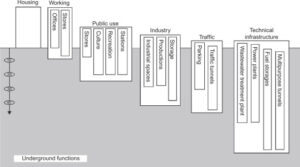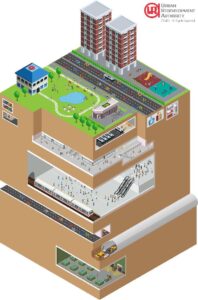Urban underground space and city development
By Jacques Besner, underground space planner
1. World urbanization
More people in the world live today in cities and metropolises than in the countryside. And they keep coming – an increasing flow of people is moving from inland to village, from village to city, from city to metropolis. The cities consume 75 per cent of the world resources and produce most of its waste. They are the major contributors to global warming that threatens human life on earth. In spite of everything, the city is always the place of greatest dynamism and creativity, representing the greatest opportunity for the future generations.
2. Consciousness of the urban phenomenon
 It is not the first time that cities have been diagnosed as sick of bulimia. A hundred years ago the unhealthy living conditions in the industrial city slums of Europe, and later North America, horrified social reformers. Bothered by the impoverished popular districts of 1890s London, a court reporter named Ebenezer Howard came up with a visionary and utopian plan for what was probably the first ‘green city’ – the Garden City. He envisaged a series of new self-sufficient towns, built in the countryside, and surrounded by agricultural belts that would supply the inhabitants with food. The Garden City would have its own industry to provide local employment. People would be drawn away from the overcrowded big cities by the promise of a better life in such towns. Howard basically believed that big cities were condemned.
It is not the first time that cities have been diagnosed as sick of bulimia. A hundred years ago the unhealthy living conditions in the industrial city slums of Europe, and later North America, horrified social reformers. Bothered by the impoverished popular districts of 1890s London, a court reporter named Ebenezer Howard came up with a visionary and utopian plan for what was probably the first ‘green city’ – the Garden City. He envisaged a series of new self-sufficient towns, built in the countryside, and surrounded by agricultural belts that would supply the inhabitants with food. The Garden City would have its own industry to provide local employment. People would be drawn away from the overcrowded big cities by the promise of a better life in such towns. Howard basically believed that big cities were condemned.
From the 1900's, the French architect Eugene Hénard denounces the anarchic congestion of the urban underground beneath streets and suggests burying the urban traffic, the fluids, waste and goods in a gallery with multiple floors. Hénard's visions already prefigure the separation of the traffics and the segregation of the functions, which will be proposed later by its contemporaries. In 1930, the American father of suburbia, Frank Lloyd Wright, dreams to replace traditional cities with spacious low-density housing, linked by highways. He assumed that each family would own a car. This plan will become the sprawling reality of post-War North America.
Inspired by Hénard, the French architect Edouard Utudjian will found, in 1937, the "International Permanent Committee of Underground Technologies and Planning" having the objective of doing the promotion of an underground space better usage, based on an observation of chaos in the big cities’ of that period. Besides, the imminence of Second World War militated for the creation of shelters intended to welcome the populations. Unfortunately, this option was firmly rejected by other thinkers, as Lloyd Wright, who favored rather a purely functionalist approach and modern solutions to relieve congestion in cities. The Swiss architect Le Corbusier also put car ownership at the heart of his plan for a ‘Radiant City’. But instead of sprawling cities he has favored high-rise geometric blocks set in open parkland traversed by great highways.
Though different in their visions, Howard, Wright, and Le Corbusier have three things in common. All wanted to open up more green spaces and revealed a will to order to segregate human functions into separate areas for living, for working, for shopping, for sport, for leisure. On their side, Hénard and Utidjian wanted a reappropriating of the city by a vertical segregation of the urban functions, an idea that will remains eccentric until the end of the fifties.
At the same moment, municipalities bulldozed older central mix-uses districts under the aegis of ‘slum clearance’, were thrown up segregated and soulless ‘new towns’ and sprawling car-dependent suburbs. There was, predictably, a backlash. One of the fiercest critics was the recently died, Jane Jacobs, who in the late 60s argued against segregation and uniformity, and for variety and diversity of cities in order to retain their natural, organic vitality. Sidewalks were important social spaces where people could interact; older buildings gave character and should be repaired not replaced; and many of the areas designated, as slums were vital functioning communities that should be improved, not demolished.
3. Sustainable development global agenda
In reaction to an increasingly explosive situation, the concept of sustainable development, which aims to reconcile the economic and social development, the environmental protection and the conservation of the natural resources, appeared gradually between 1970 and 1987. After the “zero growth” concept launched in 1970 by the Club of Rome, the Stockholm Conference of 1972 on the human environment brought United Nations to elaborate a respectful development model of the environment. Expression "Sustainable development" was proposed in 1980 for the first time by the World Conservation Union (IUCN) and spread in 1987 by the report “Our common future” of the United Nations’ Environment and Development Commission (commonly known as the Brundtland Report). This Report defines so sustainable development:
" A development that meets the needs of the present without compromising the capacity of the future generations to answer theirs. "
 Several other "operational" definitions of the sustainable development were proposed since, but none can satisfy simultaneously the justifiable necessities of all the individuals, the peoples, the companies or the organizations.
Several other "operational" definitions of the sustainable development were proposed since, but none can satisfy simultaneously the justifiable necessities of all the individuals, the peoples, the companies or the organizations.
Objectives of the sustainable development in each, sustainable development aims at three objectives: ecological integrity, equity between nations, the individuals and the generations, and the economic efficiency.
- To improve social equity, that is to allow the satisfaction of the essential necessities of the present and future human communities and the improvement of the quality of life.
- To improve economic efficiency, that is to favor an optimal usage of human, natural and financial resources.
- To maintain the integrity of the environment, that is to integrate altogether actions of the human communities and the preservation of ecosystems.
The challenge of the Sustainable development application, as far as cities are concerned, consists in seeing in our plans, policies, programs, by-laws and regulations, in brief, all of our interventions we aim at the well-balanced implementation of these three fundamental objectives.
The statement of the Rio Earth Summit Conference, adopted in June 1992 by the representatives of 180 participating countries, recommends principles enclosed in the Agenda 21. These principles serve for guiding actions allowing reaching the three objectives of the sustainable development and asserting that long-term economic progress requires a partnership and balance between the governments, their peoples and the key sectors of the urban communities. Considering the results of the Earth Summit, Habitat II proposes, in 1996, a framework for the sustainable development of human settlements: the Habitat Agenda.
Habitat II deals with all settlements and reaffirms the need for universal improvements in living and working conditions. The quality of life depends on the application of the sustainable development principles, but also on the physical conditions and spatial characteristics of villages, towns and cities. City lay-out, land-use patterns, population and building densities, transportation and access for all basic goods, services and public amenities have a crucial importance on the livability of urban settlements. The preservation of the natural and historical heritage,including sites, monuments and buildings, should be assisted. It is also of crucial importance that spatial diversification and mixed use of housing and services be promoted at the local level in order to meet the diversity of needs and expectations.
Partnerships among countries and among all actors within countries from public, private, voluntary and community-based organizations, the cooperative sector, non-governmental organizations and individuals are essential to the achievement of sustainable human settlements development and the provision of adequate shelter for all and basic services. These principles were also defined by multiple manners during the years by international organizations as well as forum about the cities, the environment and the economy.
3.1 Favoring compact cities
One of principles lies in human density itself. Highways congestion and increased daily travel time, results from the economic expansion of the 1990s, have heightened public awareness of the negative side of suburbs growth. This has led to emerging anti-growth sentiment focusing on the idea of redirecting new projects toward transit-served mixed-use development, in infill sites in the inner-ring and in older suburbs. The goal is to control sprawl and reduce dependence on automobiles. There is an obvious trend in North America toward more compact urban form, and more creative reuse of existing buildings and structures for housing. There is also a trend toward mixing and layering housing in mixed-use development.
The notion of ‘Compact Cities’ combines the organic freedom Jacobs was advocating, with some clear municipal planning to protect public rather than corporate interests. Cities where lots of people are together in a smaller area tend to be more dynamic and sociable than the sprawling ones. The obvious trend toward more compact urban forms leads toward more creative reuse of existing buildings and structures for housing. There is also a trend toward mixing and layering housing in mixed-use development.
The environmental benefits of compact cities are clear and compelling. If you can walk or cycle inside your city, that reduces the need for air polluting motor vehicles. Remember that the needs of cars take up one third of the space of an average city. Supplemented by cheap, efficient and clean underground public transport, such as subway, the compact city could be virtually pollution-free.
The model could be applied everywhere, but for the megacities of the developing world, compactness could help in a number of ways. One of the main problems facing those cities is the cost of infrastructure for clean water and sanitation. Indeed, in a low-density sprawling city it is much more expensive to provide.
3.2 Using the advantage of the 3rd dimension of the city
 In urbanized areas, the contrast between available space and the need for space for different functions is enormous. The option of the underground space usage for infrastructure, combined with a compact urban shape, might have large advantages and be an attractive alternative.
In urbanized areas, the contrast between available space and the need for space for different functions is enormous. The option of the underground space usage for infrastructure, combined with a compact urban shape, might have large advantages and be an attractive alternative.
Environmental reasons are a deciding factor to realize new infrastructure works under the ground level, particularly for transportation infrastructure and parking. In the majority of metropolises, the traffic became a real nightmare, aggravated by an ineffective public transportation organization at the surface. The growing number of vehicles generates daily traffic jams, pollutes air, and creates conflicts with the pedestrians. In order to answer to this vital need of moving in the city, several one have built subways, recessed or in-a-tunnel highways, and underground parking facilities.
In some countries, cities do not face any more to a real population growth. Instead, they are facing, since the sixties, to an industry of an “urban renovation” instead of an urban development one. The city centers have also to compete with the mega-commercial centers, strategically located along the highways in the suburb. Some local administrations, considering ways to inspire new energy to their center or to avoid exaggerated land prices at the surface, have chosen to favor the commercial underground space development in the central cities, utilizing fully the 3rd dimension of the city
4. Issues of the urban underground space
The urban form of human civilization is unthinkable without the use of the subsurface. From antiquity the urban underground sustains the concentration of people and human activities. From the water distribution and cellars of the first urban civilization, to the sophisticated utility and service networks in every of today's cities, the development of the urban underground emerged, not without some difficulties, as the sine qua non condition of urban evolution. With the growth of the world's population and the worldwide urbanization process, the urban future increasingly depends on the developing of the urban underground's potential.
 The rate, the scope and the forms of urban underground utilization significantly vary around the globe in accordance with the specific economic, demographic and geographical conditions; the technological, political and cultural factors further interfere. Despite the local particularities however, the development of the urban underground is a common and fast evolving trend throughout the metropolises.
The rate, the scope and the forms of urban underground utilization significantly vary around the globe in accordance with the specific economic, demographic and geographical conditions; the technological, political and cultural factors further interfere. Despite the local particularities however, the development of the urban underground is a common and fast evolving trend throughout the metropolises.
In many countries, underground development differentially relates to the city building practice and the urban planning process. Practice, having stepped ahead of theory, has left behind remarkable achievements alongside with an overall congestion brought by the uncontrolled invasion of pipes, tubes, tunnels and conduits in the subsoil of many cities. It is largely in response to these last effects that the need is felt worldwide of rationally planning and directing the urban underground expansion.
Many governments and city administrations emerge from the out-of-sight out-of-mind approach, so typical of most subsurface building endeavors. Today, an increasing number of local authorities subscribe to long-term policies for sustainable development of the cities, including co-ordinate actions as regards the development of the urban underground space.
4.1 Insuring a development control in the underground, as we do on surface
States have the right to exploit their own resources, and metropolises should use their right to exploit their underground space. They have the duty to see if activities exercised under their control, down there, do not cause damages to the urban and economic environment. Furthermore, each has to make sure that underground development is realized so, as to satisfy the necessities of the current and future generations. Effective local regulations, specific by-laws and measures must be promulgated, in empowerment of the official master plan.
The underground real estate projects must be managed in a systematic way, completely integrated into the urban development decision-making. As building in the underground is not only an engineering problem, the crucial step towards a good usage of the urban underground space is its integration in the economic and environmental local issues, including the fiscal and budgetary context of the city. Authorities have to sit the underground development strategies onto solid commercial, technological, planning and social information, using often a public-private partnership formula to obtain it.
4.2 Applying the universal principle of user-payer
Local authorities have also to try hard to promote the internalization of the extra costs of using by a more sustainable way the underground space. It should be by virtue of the principle according to which the user, public or private, has to pay a just price for the use of this natural “resource”, that metropolises can reach that sustainability objective, not by selling that space to the best offer, but by renting that space for the best usage. Information about the costs and the potential / constraints associated to it should so be completely accessible to allow the private market to affect effectively resources to it.
5. An Agenda 21 for the underground space of our metropolitan areas
 Many orientations suggested by Agenda 21 could be translated, through concrete principles into sustainable development realizations. Many professionals have long advocated such orientations towards a planned, viable and equitable rationale. To this understanding adhere some academic research centers and international associations, as the ACUUS.
Many orientations suggested by Agenda 21 could be translated, through concrete principles into sustainable development realizations. Many professionals have long advocated such orientations towards a planned, viable and equitable rationale. To this understanding adhere some academic research centers and international associations, as the ACUUS.
Here are some simple recommendations about the use of the urban underground space:
- Fundamental / global principle:
The basement is not a renewable resource; he recovers from the global patrimony, and its use has to be made in a reasoned and arbitrated way, as far as the set of urbanistic as economic aspects having been studied, it will be considered as an optimal solution.
- Property of the sub-soil:
The urban underground space, under as much the public domain as private lands, have an economic value and it should be usable (and be sold, bequeath or rent) at certain conditions by all urban actors, public and private, especially through public-private partnership.
- Integration to the city above:
The urban underground space, in the same way as other surface space, should be considered in the general planning of the city. Public and private real estate projects should be mix-uses and integrate public spaces and amenities for all the citizens, without social exclusion. Favoring a spatial continuance between outside and inside should do link with the surface.
The urban underground built spaces dedicated to welcome citizens should be safe and accessible to all, including handicapped peoples (as on wheel chairs).
The urban underground construction builders should consider, by necessary means and with the agreement of the local authorities, the conservation, the protection or the relocation of archaeological patrimony.
To assess and do the promotion of methods, techniques and professional skills allowing the municipalities and developers to better intervene in the urban underground, the local authorities should gather all the data describing the characteristics of that space and favor their distribution to all interested. Data and maps describing the characteristics of the buried spaces should also be prepared, with the aim of establishing a subterranean cadastre" of the urban basement.
Note: The usage of that document, totally or partially, is allowed upon authorization of the author